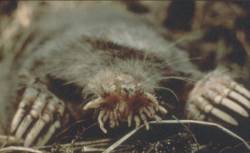- Star-nosed Mole
Taxobox
name = Star-nosed MoleMSW3 Hutterer | pages = 300-301]
status = LR/lc
status_system = iucn2.3
status_ref = IUCN2006 | assessors = Insectivore Specialist Group | year = 1996 | title = Condylura cristata | id = 41458 | downloaded =2006-05-12 ]

regnum =Animal ia
phylum =Chordata
classis =Mammal ia
ordo =Soricomorpha
familia =Talpidae
subfamilia =Scalopinae
tribus = Condylurini
tribus_authority = Gill, 1875
genus = "Condylura"
genus_authority = Illiger, 1811
species = "C. cristata"
binomial = "Condylura cristata"
binomial_authority = (Linnaeus, 1758)The Star-nosed Mole ("Condylura cristata") is a smallNorth America n mole found in easternCanada and the north-eastern United States. It is the only member of the tribe Condylurini and the genus "Condylura".Appearance and behavior
The Star-nosed Mole lives in wet lowland areas and eats small invertebrates, aquatic insects, worms and
mollusk s. It is a good swimmer and can forage along the bottoms of streams and ponds. Like other moles, this animal digs shallow surface tunnels for foraging; often, these tunnels exit underwater. It is active day and night and remains active in winter, when it has been observed tunnelling through the snow and swimming in ice-covered streams. Little is known about thesocial behavior of the species, but it is suspected that it is colonial.The Star-nosed Mole is covered in thick blackish brown water-repellent fur and has large scaled feet and a long thick tail, which appears to function as a fat storage reserve for the spring breeding season. Adults are 15 to 20 cm in length, weigh about 55 g, and have 44 teeth. The mole's most distinctive feature is a circle of 22 mobile, pink, fleshy tentacles at the end of the snout. These are used to identify food by touch, such as worms, insects and crustaceans.
The Star-nosed Mole mates in late winter or early spring, and the female has one litter of typically 4 or 5 young in late spring or early summer.
Predators include the
Red-tailed Hawk ,Great Horned Owl , variousskunk s andmustelid s, and even large fish.Nose
The incredibly sensitive nasal tentacles are covered with almost one hundred thousand minute touch receptors known as
Eimer's organ s. These were first described in theEuropean Mole in 1871 by German zoologistTheodor Eimer . Other mole species also possess Eimer's organs, though they are not as specialized or numerous as in the Star-nosed Mole. Because the Star-nosed Mole is functionally blind, it had long been suspected that the snout was used to detect electrical activity in prey animals [cite web|url=http://findarticles.com/p/articles/mi_m1511/is_n8_v14/ai_14655906|title=The electric mole - star-nosed mole may be able to sense electric fields] [cite web|url=http://links.jstor.org/sici?sici=0022-2372(199302)74:1%3C108:FOTSIT%3E2.0.CO;2-4|title=Function of the Star in the Star-Nosed Mole, Condylura cristata] , though there is little, if any, empirical support for this contention. It appears the nasal star and dentition of this species are primarily adapted to exploit extremely small prey items. A report in the journal Nature gives this animal the title of fastest-eatingmammal , taking as short as 120 milliseconds (average: 227 milliseconds) to identify and consume individual food items. Its brain decides in the ultra short time of 8 ms if a prey is comestible or not. This speed is at the limit of the speed ofneurons . They also possess the ability to smell underwater. It is done by exhaling air bubbles onto objects or scent trails and then inhaling the bubbles to carry the smell back through the nose. [cite journal | title = Olfaction: Underwater 'sniffing' by semi-aquatic mammals | author = Catania, K.C. | journal = Nature | issue = 444 | pages = 1024–1025 | date =2006-12-21 ]The star of tentacles is formed in a unique way so far not seen other places in the animal world. Instead of growing in the same way fingers grow outward on a hand, they start as swellings on the face around the nose, and some days after birth they break free and move forward in the same way a banana is peeled.
References
*cite journal|author=Catania, K.C.|year= 1999|title= A nose that looks like a hand and acts like an eye: the unusual mechanosensory system of the star-nosed mole|journal= Journal of Comparative Physiology A|volume= 185|pages=367–372|doi= 10.1007/s003590050396 (abstract on line : [http://home.cc.umanitoba.ca/~rmacarth/cataniajcp1999.html] )
*cite journal|author=Catania, K.C.|year= 2000|title= A star is born|journal= Natural History | volume=109|pages=66–69External links
* [http://www.naturalhistorymag.com/features/0600_feature2.html A Star is Born]
*Catania, Kenneth C. and Fiona E. Remple, [http://www.nature.com/nature/links/050203/050203-9.html Asymptotic prey profitability drives star-nosed moles to the foraging speed limit] , "Nature", 433, 519–522 (2005 )
*Star-nosed mole videos [http://www.vanderbilt.edu/exploration/stories/starnosedmole.html]
Wikimedia Foundation. 2010.
